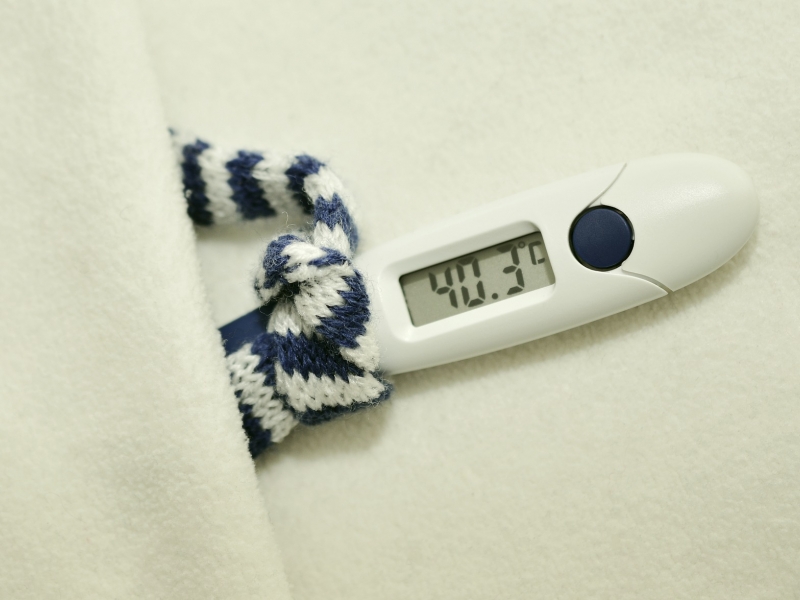For children under three, the body often responds to any infection with a temperature or fever. It is one of the first defensive reactions against the infection. It helps the body fight illness. But when is the baby overburdened and the temperature needs to be brought down?
How to take the temperature correctly
The most accurate way to take a baby’s temperature is from the rectum. When doing so you should deduct 0.5 ° C, so if you measure, for example, a temperature of 37.3 ° C, the child’s real temperature is 36.8 ° C. Which is a normal temperature.
“The best thermometers for young newborns and infants are the digital ones with a flexible tip. It is relatively accurate when measuring rectal temperature and it is fast. For older children, such as preschoolers, in my opinion, a classic mercury thermometer is best (if you have one available - they are no longer made), although you ,must help the child hold the thermometer under its arm. It is the most accurate, even if it takes longer to take the temperature,” says paediatrician Dr. Lucie Skalova.
Temperature or fever?
The average body temperature ranges from 36.5 to 37 °C. A slight temperature is from 37 °C to 38 °C. A mild fever is a body temperature from 38 ° C to 39 °C. A high fever is anything over 39 °C. During a slight temperature, up to 38 °C, there is no need to administer any drugs to reduce the temperature (antipyretics), however, make sure it has enough fluids and repeatedly measure the baby and check the temperature’s development.
When to administer medication?
When the fever is above 38 °C, it’s time to bring the fever down with medication or compresses. In general, drugs with acetylsalicylic acid (acylpyrin, aspirin) are not given to children under 15. In contrast, they can be given medication with paracetamol or ibuprofen, but only in the form of a medicine specifically designed for children. It is best to give babies the active substance in the form of a suppository.
“A substance given rectally is absorbed faster than a substance given orally. If the child is vomiting, it is also better to give the antipyretic in the form of a suppository. Then again, a suppository cannot be given if the child has diarrhoea because the substance will not be absorbed. Then it is better to give the antipyretic in the form of syrup, or a tablet for older children,” explains Dr. Skalova.
If your child still has a high temperature, you can also alternate the medicine with paracetamol (e.g Paralen) or ibuprofen (e.g. Nurofen, Ibalgin) every 4 hours. Always follow the correct dosage given in the package leaflet, paracetamol is very toxic to the liver. If in doubt, consult your pharmacist or doctor.
Compresses
If the fever does not start to drop within an hour despite having been given medication, it is possible to try to reduce it with a lukewarm shower or a compress. A compress is prepared by soaking a towel or cloth nappy in lukewarm water and wrapping the child’s chest from the armpits to the lower edge of the ribs - do not cool the legs, arms and abdomen. “Before putting the compress on, the upper and lower limbs must be well perfused, i.e. warm to the touch, if they are cold, or the skin is marbled, do not put the cold pack on - there is the risk of shock. However, I would certainly not use a compress on very small newborns and infants,” adds Dr. Skalova.
Over the next two hours, repeat the compress a total of three times, or until the temperature drops by a degree or two. Never try to reach normal temperature. To prevent the bed from getting wet, place either a disposable pad or a thick towel under the child. Never use plastic.
Other measures
With a mild temperature or fever, the child usually does not have much appetite, but it is very important to ensure a sufficient supply of fluids. Dehydration could cause a rise in temperature. Therefore, it is best to give the baby teaspoons of boiled water or cold weak tea. If the baby is fully breastfed, it is enough to breastfeed as the child desires - there is no need to give additional fluids with water/tea. It is also important to keep an appropriate room temperature. Lightly cover the baby, so that it does not overheat even more.
If the baby has a temperature of around 38.5 °C before bedtime, check during the night that the temperature has not risen dangerously high.
If you have any doubts at all, or if the fever does not go away on the third day, see a doctor.

